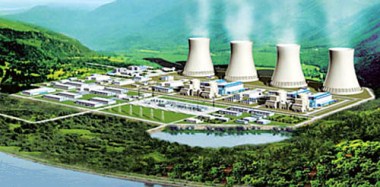China's first inland cooling contract
21 April 2010
China's first inland nuclear power plant will feature the world's largest cooling tower, courtesy of Germany's GEA Group.
All of China's 11 operating nuclear reactors, as well as the 20 under construction, are sited on the coast, meaning they can use sea water for cooling. However, the country's extensive plans for nuclear development see a number of new nuclear sites springing up inland, the first being Taohuajing in Hunan province.
The plant's name means Peach Blossom River, representing its location, and it will eventually sport up to four Westinghouse AP1000s producing 1250 MWe each using natural draft cooling to completely avoid heat impact on the river.
 |
| Taohuajiang as imagined with generic reactors rather than AP1000s |
The contracts for these reactors with vendor Westinghouse are not yet complete but are believed to be coming soon. Construction is slated to begin in September this year.
For Taohuajiang 1, GEA Group is to construct the world's largest cooling tower: a natural draft unit some 200 meters in height and 160 metres in diameter, far taller than the AP1000 buildings which reach only around 60 metres. A contract for this was signed on 7 April.
GEA boasts a manufacturing base for cooling systems in Chanshu, near Shanghai. It has also recently provided cooling towers using its Heller dry natural draft technology for a coal power plant with two 600 MWe boilers.
Jurg Oleas of GEA said: "Due to the water scarcity in the power producing regions of the country in combination with China's need for energy efficient power production, the use of the most advanced systems is a key issue to the Chinese power industry. This new order underlines this development in the market."
Besides the two units under construction at Sanmen and Haiyang, the next wave of AP1000 development in China is to be at Taohuajiang and Xiaomoshan in Hunan province, Xianning in Hubei province and Pengze in Jiangxi.
Researched and written
by World Nuclear News